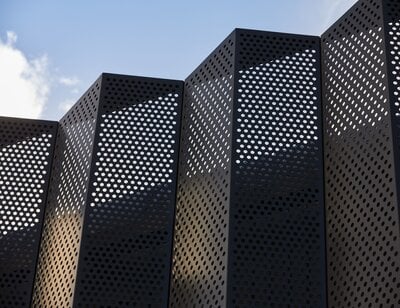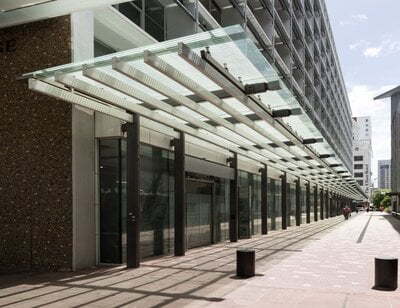Two topics that feature heavily in business news feeds are productivity and wellbeing. They are not mutually exclusive, with proven links between the two. That's probably not news to most. But what might be news is that both are also linked to facades. Specifically, how facades aid natural ventilation, control light exposure and assist in the passive management of thermal gain. What that does for productivity and wellbeing is significant and worth of discussion.
The Importance of Employee Productivity
By all accounts, New Zealand has an issue with productivity. The average Kiwi works 34.2 hours per week, which is significantly higher than the OECD average of 31.9 hours. Yet since the end of the Second World War, our productivity has declined, and where we were once one of the most productive countries in the OECD, we are now one of the least productive. The (relative) stability and growth experienced in GDP in recent years has come not through productivity gains but increasing hours. Essentially, the economy is being propped up by Kiwis working longer hours. That is obviously unsustainable. There are a finite number of hours available to work and, no doubt, a finite appetite for working them all. Which means some rebalance is to be sought and productivity has to increase.
Just how this can be done has no doubt perplexed finer economic brains than ours. What we do know is that an increase in productivity aids the effective utilisation of resources and can lower overhead costs, which helps businesses operate more smoothly and position themselves for growth. Or achieve a bigger profit. And we also know that facades can help with that. More on that soon. First, let's talk about the importance of wellness.
The Importance of Employee Wellbeing
Wellbeing is a big issue which straddles the key touchpoints of an individual's life; career, social, financial, physical and community. The areas are interlinked and together can be said to represent 'how someone's life is going'.
It's not untypical for employers to as themselves why they should spend time and money on employee wellbeing. it's a simple question with a complex answer. The interdependencies of wellbeing are such that it tends to bleed over into all aspects of a person's life. And whilst it might be considered difficult to draw a cause and effect line between someone's social wellbeing and their attitude at work, we've likely all experienced it. A bad date the night before can make Gary an unhappy camper in the office the next day. There is an undoubted connection where the home life influences the work life, and vice versa.
The elements of wellbeing are cumulative. Every small thing in one area of wellbeing adds to every small thing in another. As the number of 'small things' grows, as does a person's wellbeing. For an employer, it means incremental improvements become important. There is no silver bullet to solving wellbeing issues and there is much to be gained by spreading the 'wellbeing risk' across a number of initiatives. Should you fall short in one area, any possible negative effects are mitigated by the myriad of other, positive initiatives which are working.
The results from successful implementation of a wellbeing initiative can be significant, with improvements in customer engagement, safety incidents, staff retention and, of course, productivity. This is usually followed by profitability gains which outweigh the cost of any wellbeing initiatives.
So many a facade might even 'pay for itself?' That might be taking it too far.... or is it?
The Importance of Fresh Air and Daylight
Researchers from Harvard University examined the effect of air quality on cognitive function in the ground-breaking COGfx Study. It focused on the hypothesis of cognitive function being a prime indicator of productivity, and how both might be affected by manipulating the ventilation rates in the working environment.
The study placed participants in a controlled environment and had them go about their normal tasks. Essentially, they were simply doing the same job in a different location. Except there was another, imperceptible change. The air quality of the working environment was manipulated each day, with the levels of ventilation adjusted, along with volatile organic compounds (VOCs) and carbon dioxide. At the end of each day, participants had to complete a cognitive function test that measured performance in; basic activity level, applied activity level, focused activity level, task orientation, crisis response, information seeking, information usage, breadth of approach and strategy.
The tests found conclusively that when the amount of fresh air was increased (lowering VOCs & CO2), high-order cognitive function across all the 9 domains increased. The best results were achieved when the ventilation rate was increased from the acceptable level for US buildings of 20 cubic feet per minute per person, to double at 40 cfm. Simply put, introducing more fresh air improved employee productivity.
The COGfx study is not alone in linking fresh air to productivity either. There have been numerous studies regarding the effect of fresh air in learning environments, showing how better ventilation rates quantifiably improve maths, reading and science scores. 'Designing Indoor Learning Spaces: Indoor Air Quality & Thermal Gain' by the Ministry of Education is one of them and supports the view that fresh air is beneficial for increased productivity. As does it note the importance of daylight, which has long been associated with improvements in mood and morale.
A prime example of this link between daylight and productivity comes from Lockheed Martin. When they charged their offices to provide increased exposure to daylight a productivity gain of 15% was recorded. The sums of this are impressive, as they calculated every 2% gain in productivity equated to $3 million saved (per year).
Quantifying the Benefits of a Facade
A louvre facade has the obvious benefits of being able to increase ventilation rates by allowing windows to be opened. They allow natural daylight to flood the working environment whilst providing shade when it is needed, being the point at which it is considered to become negative with glare being problematic and distracting.
It might be impossible to model the precise gain to be expected from adding a facade to your building, but we can make a number of assumptions supported by science. We know that increasing fresh air increases cognitive function and this positively impacts productivity. We know fresh air increases your serotonin levels and this enhances your mood, fighting against depression and anxiety, aiding your overall wellbeing. And we know that an increase in wellbeing leads to an increase in productivity. So, it's a virtuous circle, albeit one we can't attach a $ sign to. Some smart people at Harvard can though.
In 'Healthy Buildings: How Indoor Spaces Drive Performance and Productivity (Harvard University Press, 2020), Joseph G Allen and John D Macomber created a fictional 40-person company and factored their research into their accounts. Remember the research mentioned previously about fresh air improving cognitive function? They suggest the improvements were good enough for a productivity increase of between 2 and 10%. Taking the lowest figure of 2% and adding a drop of absenteeism of 1% (fresh air reduces time off with illness) they did the maths to prove it was enough to add 9% to the bottom line of a company. Let's not forget, this is without the circa 15% productivity gain Lockheed Martin reported from improving access to daylight, so the bottom-line gains could likely be even greater.
We know it's always possible to dispute numbers and the effect of adding a facade will no doubt vary from location to location, and from one group of people to another. Yet, we can and should be confident the effect on productivity and wellbeing is significant, so much so the effect on the bottom line will be significant. Indeed, we firmly believe the impact is enough that the facade will more than pay for itself.
Let's look at it another way though. It's easy to spend a small fortune on consultants and course to improve productivity and wellbeing. But what if one of the biggest difference makers is as easy as adding a louvre facade to the exterior, opening the windows and enjoying some sunlight?
We think it is.








